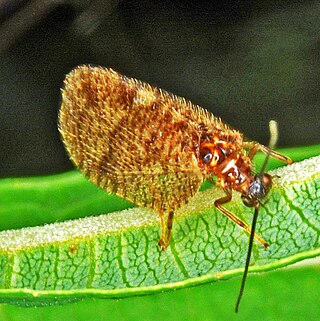
Green lacewings are insects in the large family Chrysopidae of the order Neuroptera. There are about 85 genera and 1,300–2,000 species in this widespread group. Members of the genera Chrysopa and Chrysoperla are very common in North America and Europe; they are very similar and many of their species have been moved from one genus to the other time and again, and in the nonscientific literature assignment to Chrysopa and Chrysoperla can rarely be relied upon. Since they are the most familiar neuropterans to many people, they are often simply called "lacewings". Since most of the diversity of Neuroptera are properly referred to as some sort of "lacewing", common lacewings is preferable.

Osmylidae are a small family of winged insects of the net-winged insect order Neuroptera. The osmylids, also called lance lacewings, stream lacewings or giant lacewings, are found all over the world except North and Central America. There are around 225 extant species.

The Berothidae are a family of winged insects of the order Neuroptera. They are known commonly as the beaded lacewings. The family was first named by Anton Handlirsch in 1906. The family consists of 24 genera and 110 living species distributed discontinuously worldwide, mostly in tropical and subtropical regions. Numerous extinct species have also been described. Their ecology is poorly known, but in the species where larval stages have been documented, the larvae are predators of termites.

Alderflies are megalopteran insects of the family Sialidae. They are closely related to the dobsonflies and fishflies as well as to the prehistoric Euchauliodidae. All living alderflies – about 66 species all together – are part of the subfamily Sialinae, which contains nine extant genera.

Ascalaphinae is the type subfamily of the neuropteran owlfly family. Most species are found in the tropics. Their characteristic apomorphy, shared with the Ululodinae, is the ridge which divides each of their large compound eyes; both groups are thus sometimes known as split-eyed owlflies.

Chrysoperla is a genus of common green lacewings in the neuropteran family Chrysopidae. Therein they belong to the Chrysopini, the largest tribe of subfamily Chrysopinae. Their larvae are predatory and feed on aphids, and members of this genus have been used in biological pest control.

Chrysopinae is the nominate subfamily of green lacewings in the insect family Chrysopidae in the order Neuroptera. This subfamily is also the largest within the family and comprises about 60 genera.

Semachrysa is a genus of green lacewing found from Japan to Australia along the Western part of the Pacific Ocean. 20 Semachrysa species have been described between 1914 and 2012. 15 of them - one of which was new - have been included in a recent taxonomic study:
Apertochrysa arcuata is a species of green lacewing.
Apertochrysa flavinotala is a species of green lacewing.
Apertochrysa pilinota is a species of green lacewing.

Chrysemosa is a genus of green lacewings in the family Chrysopidae. They are distinguished from related genera based on male genital structures. The small and distinctive C. jeanneli is a commonly encountered species in orchards, fields and gardens of southern Africa.

Sympherobius is a genus of brown lacewings in the family Hemerobiidae. There are at least 50 described species in Sympherobius.

Chrysopini is a tribe of green lacewings in the family Chrysopidae. There are about 32 genera and 926 described species in Chrysopini.

Dendroleon is a genus of antlions in the family Myrmeleontidae. There are more than 20 described species in Dendroleon.

Leucochrysini is a tribe of green lacewings in the family Chrysopidae. There are 7 genera and 213 described species in Leucochrysini.

Megalomus is a genus of brown lacewings in the family Hemerobiidae. There are more than 40 described species in Megalomus.

Psectra is a genus of brown lacewings in the family Hemerobiidae. There are more than 20 described species in Psectra.

Apertochrysa sierra is a species of green lacewing in the family Chrysopidae. It is found in the western United States and Baja California, Mexico.

















